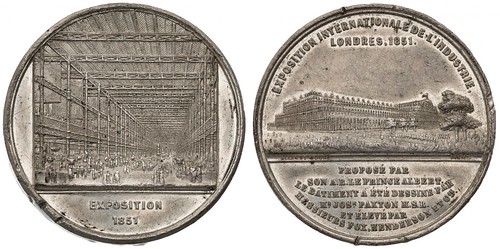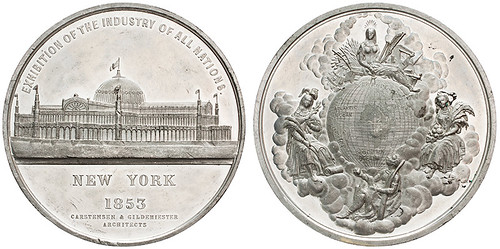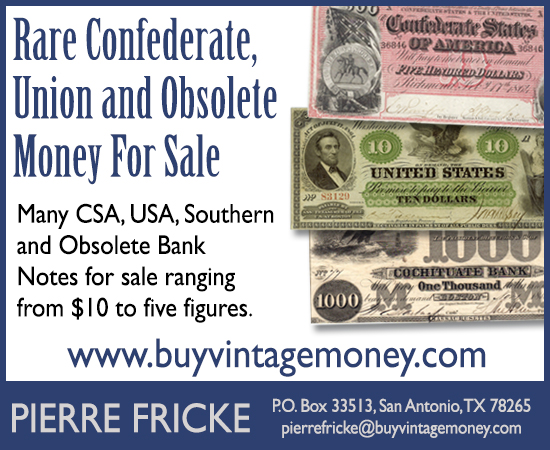
PREV ARTICLE
NEXT ARTICLE
FULL ISSUE
PREV FULL ISSUE
CRYSTAL PALACE MEDALSElena Stolyarik published a great article on the ANS Pocket Change blog about the Crystal Palace medals - both the original in London and the one in New York City, both of which met the same tragic end. Here's an excerpt, but be sure to see the complete article online. -Editor The collections of the American Numismatic Society include many medals pertaining to famous architecture, including some of buildings which have been destroyed since their medallic depiction. Among these are the medals dedicated to the Crystal Palaces of London and New York. The original Crystal Palace was built in London's Hyde Park in 1851. It was designed and erected by the famous English gardener and architect Joseph Paxton (1803–1865). As head gardener for the Duke of Devonshire, Paxton had already designed and built major greenhouses for his employer. His plan for the Crystal Palace was based on that experience as well as the cruciform shape of Gothic churches. Construction of this technically innovative building, the largest in the world at the time, took only 17 weeks, because it was assembled from prefabricated modular cast iron columns and beams and standardized glass panes. At times there were 2,000 people working to build it, but it cost less than £180,000 to build—much less than any of the competing designs. It stood 135 feet tall, with a length of 1,848 feet and a ground floor area exceeding 770,000 square feet.
The building was originally created for the Great Exhibition of the Works of Industry of All Nations, the first London's Great Exhibition became the model for subsequent World's Fairs organized in various countries. In July 1853, New York emulated London's example with its Exhibition of the Industry of All Nations. Like London, New York built a modern structure of cast iron and glass for its exhibition and named it a Crystal Palace. It was designed by the Danish-American businessman Georg Carstensen (1812–1857) and the German-American architect Karl Gildemeister (1820–1869). Constrained by the limited space available, the location that is now Bryant Park in Manhattan, they designed it in the form of a Greek cross with an enormous central dome. When it became clear that the building needed more space for exhibits of machinery, they modified the ground floor to an octagonal shape. The Exhibition of 1853 in New York was the first World's Fair held in the United States, and it served to promote the achievements of the young nation and its largest city. Thousands of exhibitors presented their consumer goods, artworks, and technological innovations to more than a million visitors. After the Exhibition closed in 1854, New York's Crystal Palace was used for other events, but unfortunately it met the same fate as its exemplar in London. The building was destroyed in a fire in less than half an hour in 1858.
To read the complete article, see:
Wayne Homren, Editor The Numismatic Bibliomania Society is a non-profit organization promoting numismatic literature. See our web site at coinbooks.org. To submit items for publication in The E-Sylum, write to the Editor at this address: whomren@gmail.com To subscribe go to: https://my.binhost.com/lists/listinfo/esylum All Rights Reserved. NBS Home Page Contact the NBS webmaster |


